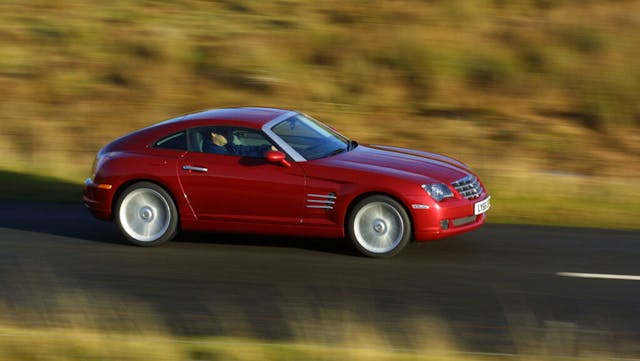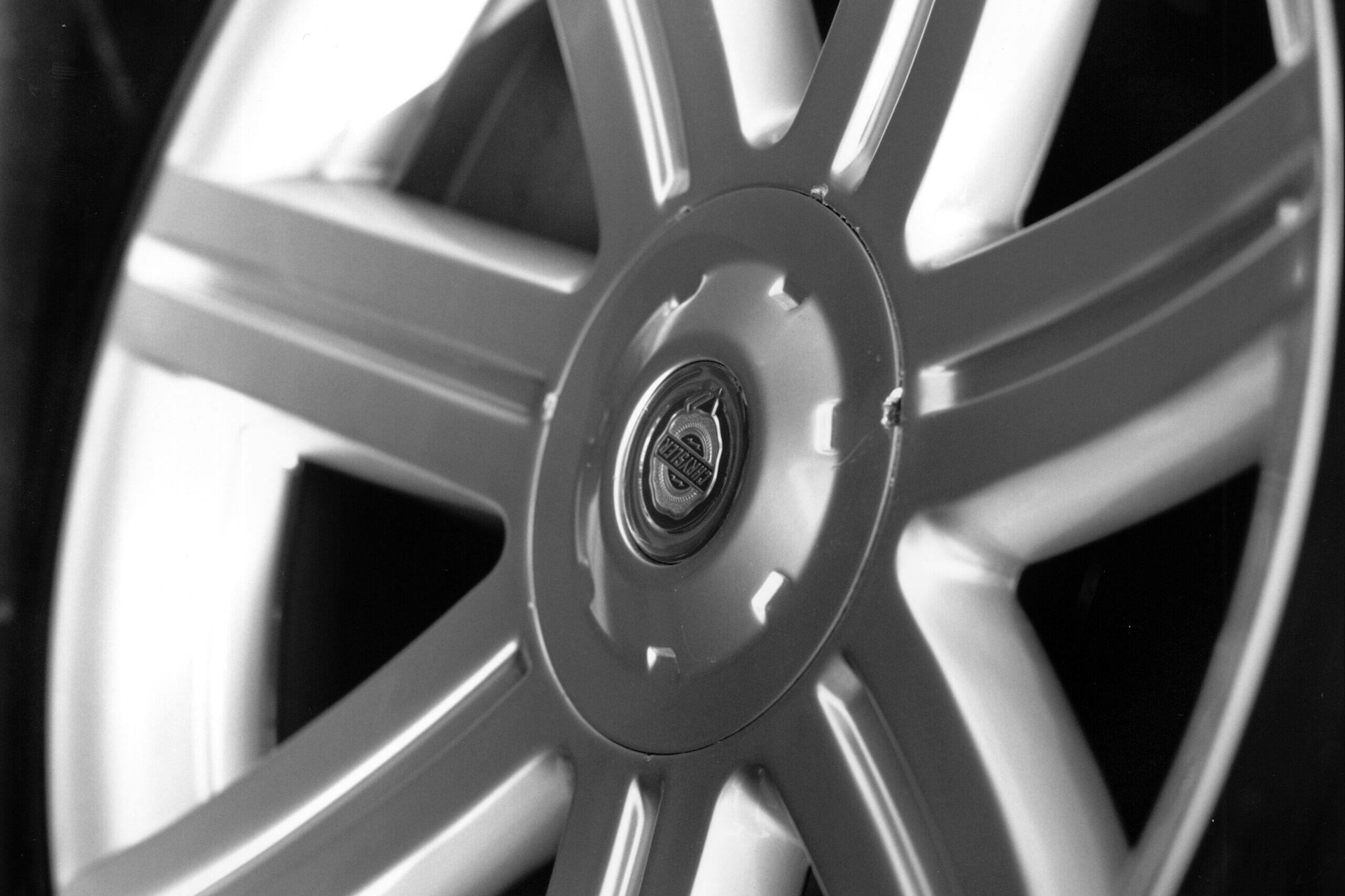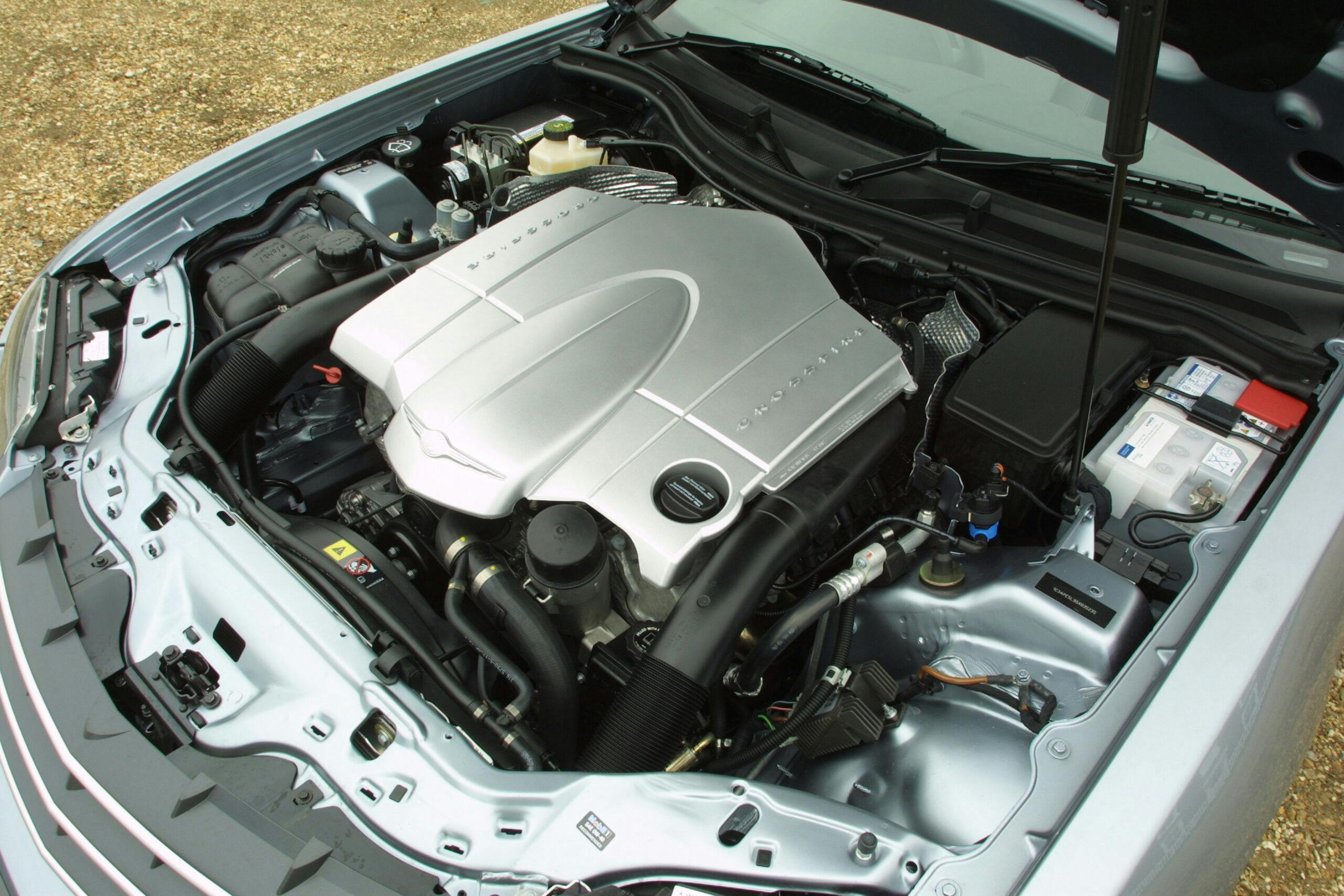After 20 years, the Chrysler Crossfire is making inroads in the collectible market
Daimler chairman Jürgen Schrempp, an architect of the 1998 merger that resulted in DaimlerChrysler, described it then as a “marriage made in heaven.”
But for five years, it appeared that the couple had taken a vow of chastity. Where was the first child from that Chrysler and Mercedes marriage?
In 2003, it was finally delivered: A 3084-pound bouncing baby sports car named the 2004 Chrysler Crossfire. The platform, suspension, and drivetrain were from the Mercedes SLK—Chrysler claimed that nearly 40 percent of the car was Mercedes, but it felt like more, from the 3.2-liter, 215-horsepower normally aspirated V-6 to the awkward cruise-control stalk that hung from the steering column. Still, using Mercedes mechanicals trimmed the development time to a brisk 24 months, at a bargain cost of $275 million.
The art deco styling was all American, though. Designer Eric Stoddard penned the original concept car that debuted at the Detroit auto show in 2001, and the resulting production car looked remarkably like it; toned down a bit on all four sides, but faithful.

The Crossfire was Chrysler’s first sports car, but like the SLK roadster, it was less a performance car than a casual cruiser. (“The blended DNA of Daimler-Benz and Chrysler Corporation produced its first offspring in 2003, and hairdressers rejoiced,” wrote Hagerty’s Aaron Robinson, then of Car and Driver.) 215 horsepower impressed no one at a time when the Honda Accord was available with 240 horses.
That said, the car handled quite well, less a result of the independent suspension—double wishbones up front, multilink in the rear—than the massive Michelin Pilot Sport radials: 18-inch 225/40ZRs in front and 19-inch 255/35ZRs out back. All-season Continentals were an option, and either choice was mounted on flashy alloy wheels. The fairly soft suspension tempered the ride over rough pavement, helpful when you have a car with a short 94.5-inch wheelbase. Steering was a dated recirculating-ball unit; brakes, from the SLK, were excellent.
That wheelbase was the same as the SLK. The rear-drive Crossfire was a tenth of an inch longer, but about two inches wider, which added room to the interior. The platform was extremely stiff—stiffer than a Porsche 911, Chrysler claimed.
“Crossfire could have been tuned as a boy racer, but we took a more refined approach because Chrysler is a premium brand. It’s a plush car, but not so plush you have to be bashful when it comes to handling or performance,” said Larry Achram, then Chrysler’s vice president of advanced vehicle engineering, at the model’s introduction.
Inside, the high beltline and smallish windows made for a slight submarine feel. Visibility, especially when backing out of a parking space, was a challenge. Rear visibility was trimmed further by the automatic power spoiler, which popped up as the Crossfire approached 57 mph. The awkward cupholder was apparently added as an afterthought.
Transmission was a passable six-speed manual, or a five-speed automatic, both from Mercedes. Aside from tires and color, the transmission was your only major choice to make at the dealership. ABS, traction control, and stability control came standard.
Inevitably, those who wanted either more boy-racer power or a convertible roof, or both, only had to wait a year or so. The SRT-6 used a Japanese-built supercharger and an intercooler to boost horsepower by 115 to 330. Alas, the manual transmission was missing from this version.

The convertible was a soft top, unlike the retractable roof on the SLK. The open-air feeling was nice with the top down—no major wind buffeting, and much-improved side visibility.
The SRT-6’s stiffer suspension and improved handling came at the expense of the ride, though—it became jarring on road transitions and bumps and potholes. Chrysler salespeople usually mapped out a route of smooth pavement for prospective SRT-6 customers.
At introduction, the price of the Crossfire was $34,495 for the manual model, $35,570 for the automatic, including shipping. Figure about $5000 more for the convertible, $10,000 for the SRT-6. Get both, and you topped out around $50,000.
In terms of sales, the prices may have been optimistic, as the Crossfire was marketed against other attractive imports (the Crossfire was built at the Karmann plant in Germany) like the Audi TT, Nissan 350Z, Infiniti G35, and Mazda RX-8. Chrysler wanted to sell 20,000 Crossfires a year: They managed that through 2005, but sales fell off a cliff in 2006. Chrysler even eliminated a few features in 2005 to offer a true “base” model, with a price closer to $30,000. You can tell one by the absence of fog lights. 2008 saw Crossfire production draw to a close.

Which brings us to the present. Anecdotally, several of our team have encountered die-hard Crossfire enthusiasts who remain doting owners or remember their Crossfire experiences with a fondness usually reserved for family pets. It’s not too hard to see why—the Crossfire, in any configuration, can be a fun and affordable weekend toy.
The car is reasonably sturdy thanks in part to the Mercedes underpinnings, unless you are one of the unfortunate owners who has experienced perplexing electrical problems. Overall, though, maintain it like you would any older car, and the Crossfire should provide years of good service.
While we don’t track the Crossfire in the Hagerty Price Guide, we are seeing signs that the little sports car is beginning to achieve some collector status. Our insurance policies written on Crossfires have more than doubled since 2018—it’s still a modest amount of cars insured, but the increase is substantial. Also up is the number sold at collector car auctions: only five Crossfires made it to public auction in 2015, but that number has steadily increased to 71 so far in 2023.
Based on insurance quotes sought, buyer demographics have remained consistent over the last four years. Boomers are the most enthusiastic, at 63 percent of buyers, followed by Gen X at 20 percent. Younger buyers have held steady at a little more than 5 percent since 2020.
The average value of $13,727 on those policies is about the same as it was in 2018—it’s actually down $200. Auction prices are a touch higher, with the average sale price for the base car coming in at $14,319, while the SRT-6 commands a 27-percent premium, coming in at $18,200. We’ve seen high-mileage versions go for considerably less.
The Crossfire is a handsome, undeniably distinctive sports car with no glaring faults. It may not yet be unanimously considered a collectible, but it’s on its way.
***
Check out the Hagerty Media homepage so you don’t miss a single story, or better yet, bookmark it. To get our best stories delivered right to your inbox, subscribe to our newsletters.







This was. Chryslers SSR.
Not a great sports car and not very popular. If you want one because you like it that is a good investment. But you will never get rich here if that is the motive.
I never drove an SRT-6, so don’t know how it would compare to an SLK AMG I did drive, but the regular and convertible Crossfires were OK. They are like the Chicken Caesar salad at a restaurant – there’s always a better choice.
I have been immensely blessed by being the recipient of a 2004 Mercedez Benz sport roadster convertible w/Kompressor supercharged 2.3L 4cylinder engine. This car was a present fm my beloved sister. This little hot rod is so wonderful. It has been meticulously taken care of by Long Mercedez Benz of Chattanooga, Tennessee since I received it in February of this year. Everything has been gone over and either upgraded or replaced. I have enjoyed driving it since it was made road worthy last month. New Michelin tires, fresh fluids, (brake, oil, transmission, coolant, windshield washer fluid, etc.) all were drained and replaced. It is a beautiful black on black on black and is an eye catcher. I had a new magnaflow exhaust installed and it sounds great. Performance wise, it runs wonderful. 0-60 in about 5 seconds! I haven’t seen all it will do yet since I am 73 years old and am not the hot rodder I used to be. it registers 160, Ive seen 140mph and it was still accelerating. I ran out of real estate! lol This little gem is everything I ever hoped for and more. I cruise around Gatlinburg, Tennessee during rod runs and catch everybody’s attention. Like I said it is a dream come true.
These were a sports car that really never had a place. It was not real sporty, not real luxury and not really at the top on any point. But it was an improvement over a K car convertible and Maserati Chrysler.
I know a lot of people who joked about the “dog taking a crap” shape and other detractors, but I always thought the car was attractive. Not quite enough to ever have made me want to buy one, apparently, as I can’t say that I ever even drove one. But I still look when I see one on the road!
I have always been attracted to these. I remember when I first saw the concept. I thought Corvette killer.
Too bad it was never really a big performer.
They sold close to their target quantity. They wanted 20,000/year and sold 76,000 in 5 years. Better than the T-Bird deal.
Serendipitously picked one up and insured it at Hagerty here just 3 days prior to the publication of this article. Nice to know it may some day appreciate in value but I bought it to enjoy – and so far I am!
I never got into this car. I still love Top Gear’s review of this car.
You just can’t polish a turd. Chrysler failed on that one. They should have made the Copper head.
Mercedes drive train shipped to Ghia for assembly with American parts and shipped back to America.
This is a collectors car formula.
Here are some previous successes when Chrysler and Ghia worked together.
https://www.hagerty.com/media/automotive-history/when-chrysler-wanted-wow-it-called-ghia/
Bring a trailer results
https://bringatrailer.com/listing/2005-chrysler-crossfire-103-2/
The article states that assembly was at the Karmann plant in Germany.
I really enjoyed my time with an SRT-6 in black with only about 10K on the odometer and this was only about 8 years back. In black I found myself always looking back at it as I walked away and that is the barometer of how you feel about a car. It did the 0-60 time around 5 seconds which is nothing to slouch about for this era of car. The aftermarket tuning community is rabid for the Crossfire as well so it does have that legacy. It just wasn’t that bad truthfully.
You can’t give a SLK away, so it is no surprise that the Crossfire is a misfire. The MB 5 speed is a distant second to the Boxster manual box. I would not bet 401k money on this “investment”.
I didn’t realise that there were that many hairdressers that were into car collecting. Seems that the audience for this somewhat misfitting vehicle would not want a real sports car or grand tourer, but a wannabee. I think the note comparing it with the canine function pretty well got it right..
Replying to Steve, the Crossfire was not built by Ghia but was built by Karrmann in Germany, the same company that built the VW Karmann Ghia. At that time Karmann and Ghia were working together but the Crossfire is strictly a Mercedes/Chrysler child. It was completely assembled by Karmann and then shipped to the U.S and other markets.
I have always carefully selected the cars for my garage and tend to keep them for long periods. I also tend to not favor mainstream cars as I do not want to meet myself at every street corner. That said, I admired the Crossfire design when it was first shown but could not afford the entry cost. I have always enjoyed small and nimble cars and the Crossfire met the requirements.
After a few years the cost came within range and I started trolling the internet. I found a 2005 SRT6 Roadster with 17K miles, California car with little exposure to rain, which I purchased for $ 15K in March of 2020. Sometime about a year and a half later I noted that a twin to my car, model, color, and mileage, sold on BringATrailer for $ 22K. I did not buy my car to flip it, so watch the values but they do not influence my desire to sell or keep the car.
For the record, I am beyond 75 year of age and plan to keep the car until I cannot drive it any more. I enjoy it a lot on the roads in the Ozark Mountain area.
There is a small market for the five-speed transmission (usually sourced from wrecks or flood cars) for installation into 320/350 CLKs, which only came to the US with automatic transmissions. While the transmission bolts to the engine and the drive shaft, it is not a simple conversion. The transmission tunnel needs to be “modified” and a bunch of parts have to be sourced from Germany, then you have to reprogram all kinds of things so the car recognizes that it has a different transmission – it CAN be done, but it is not simple or even really worthwhile. It is a shame the manual transmission is nothing special, if it were a good one, the conversion *might* start to make a little more sense. My solution is to keep my CLK intact and also buy a good Boxster.
Almost jumped on a $10K SRT-6 convertible, but it had too many issues for me. Inoperative top that owner was just opening and closing manually, aftermarket wheels and cheap tires, lowering kit, and who knows what other things to be undone elsewhere. I learned long ago to pay a bit more for something that has been properly maintained.